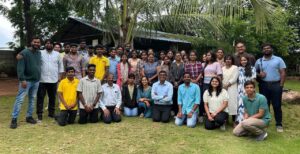Editor’s Note: Dr. Gali Artzi is CTO and partner, Eva Everloo is a senior analyst, Nurit Ben is head of comms, and Aaron Zanger is an investment analyst at agrifood tech investor PeakBridge.
The views expressed in this guest commentary are the authors’ own and do not necessarily reflect those of AgFunderNews.
Commodities are top of mind, and topping headlines: Supply shortages. Record-high prices. Volatility. Yet not many global commodities have an entire culture built around them; a culture that varies, yet exists, in nearly every country around the world. A commodity that’s a fixture in so many people’s solitary moments and a purpose of gathering all on its own. How often have you offered a friend or acquaintance, ‘Let’s meet for coffee?’
It’s one you could even argue plays a role in our persona: do you have a penchant for double espresso, instant coffee, or the Frappuccino? Noa Berger, an author and researcher in the sociology of coffee, notes it’s not just the place it takes in our lives but the role we have as consumers. “With chocolate, you buy a bar, and you eat it and that’s it. Or you buy a bottle of wine, and you open it and drink it. But in coffee, consumers are often involved in the preparation, whether in a cafe or through the act of making oneself coffee at home.”
Yet few of us give much thought to the highly complex journey traveled on the way to the cup in our hands. As we’ve increasingly witnessed over the last couple of years, it turns out that journey is not only complex, but increasingly fragile and subject to robust forces that are here to stay.
The sector is today sandwiched between strong tension on supply and a pull from consumers. Mike Hecker spent decades at Nespresso, from its earliest days: “You have two major things playing into the category,” he says. “Customer preferences and climate change – and they’re both going to lead to major changes in coffee.”
So what’s next for one of the world’s most beloved commodities? We mapped out the major disruptions and most promising solutions shaping the future of coffee, from crop and flavor innovation to deep-tech alternatives.
A supply chain under pressure
Any conversation about coffee has to start with the reality the commodity is dealing with – and the forecast is not rosy. As we’ve witnessed with a number of other key commodities from wheat to cocoa and vanilla, the global supply chain is complex, vulnerable, and increasingly fragile. At play are a host of forces: Rising global temperatures and changing weather patterns are already straining the crop and could render over half of current coffee-growing regions unsuitable by 2050.
Arabica, which makes up about 60-75% of global production, is particularly vulnerable to even slight changes in temperature. We’ve seen that play out in price of late, with wholesale Arabica trading near a 50-year high.

Coffee also happens to be resource-intensive, consuming a stunning average of 140 liters of water per cup, and generating high carbon emissions in the process. Add to that diseases like coffee leaf rust: a fungus that has popped up around the world, with potential to slash yields by as much as 80%. And lest we forget geopolitical instability and rising labor costs, both of which are adding to price volatility.
For longtime industry players, it’s a fact of life. “The cost of the commodity was always an issue and will remain an issue. And the volatility is increasing,” says former CEO of Strauss Coffee, Tomer Harpaz. “There’s a huge gap between the volatility of the commodity and the consumer tolerance for it. To bridge that gap and manage that tension, there’s a very sophisticated world of financial derivatives and hedging mechanisms. We had a whole expert team based in Switzerland of experts whose only job it was to manage the financials around procurement globally and hedge our exposure.”
Consumer trends: This isn’t your mother’s coffee
Those combined forces above are enough to spark concern in the industry and a search for solutions – but of course, that’s not the whole story.
Global consumption is holding strong, with coffee culture expanding to new frontiers: China, Japan and India have all seen significant growth in demand, fueled by urbanization and a growing middle class. China’s consumption alone has tripled over the past decade, alongside aggressive expansion of chains like Starbucks and its local competitor Luckin Coffee. With more consumers turning to coffee, what exactly do they want?
Trends are pulling towards change, from environmental factors to a growing demand for built-in health benefits. On that front, let’s unpack what’s top of mind.
Health and wellness
When we talk about consumer expectations, health and wellness are increasingly non-negotiable.
Across food and beverage these factors are taking focus: A recent McKinsey study notes no less than 82% of US consumers consider wellness a top or important priority in their everyday lives, with 87% in China and 73% in the UK reporting the same. Drilling down into what we put into our bodies, a third of US consumers are prioritizing wellness in what they eat and drink, driving $638 billion in spending power – and coffee fits squarely in that space.
In the US alone in 2022, 92% of coffee lovers stressed the importance of health benefits in their cup. Enter a slew of functional beverages gaining traction like mushroom coffee, targeting health benefits including improved cognition and focus.
Sustainability and traceability
Consumers show a rising demand for ethical and eco-conscious products, prioritizing traceability and environmentally friendly farming practices. That’s in an industry with a distinct lack of transparency and standardized tracking systems. As Berger explains, “Traceability and transparency have been an intense preoccupation of coffee professionals for the last few years, trying to break down the price for consumers. But it’s very hard to know the distribution of revenue from the coffee we consume, because it just goes through so many hands.”
Adding to the complexity is fragmented production: according to the nonprofit World Coffee Research, 60% of the world’s coffee is produced by about 12.5 million people, largely on smallholder farms.
What about the “fair trade” concept we’ve all come to recognize? Hecker believes that’s ultimately more of a label than a real benefit. “At the end of the day, do you see how much the farmer benefitted? No. You trust that they are.” On the environmental side, traditional coffee farming has negative impacts on biodiversity and carbon footprints, increasing the urgency for regenerative agriculture for everyone from farmers to traders, brands and retailers.
Convenience
Modern life has trained us to expect extreme convenience at every turn, and that certainly holds true for what we eat and drink. One in five consumers globally say they use convenience foods more than once a day. Not surprisingly the US remains a strong market for those, with developing countries like India and Indonesia showing surges in growth in the sector.
When it comes to convenience, formats like ready-to-drink (RTD) and single-serve options dominate. The RTD market is estimated to hit $5.7 billion this year, rising to $7.2 billion in the next five years, with flavors taking focus, and Gen Z leading the way.
New generation, new tastes
In many ways coffee reflects the era in which we drink it, with preferences shaped by cultural, economic, and technological influences. It’s a generational product, and the young generation tends to have something quite different in their cup than their parents. Research from Coffee Business Intelligence maps out those evolving preferences, from baby boomers’ drip coffee to millennials’ penchant for specialty brews (high-quality, often sustainably sourced products), and Gen Z’s love for the new and convenient.

The state of innovation
With the potent combination of extreme weather events, a stressed supply chain, and shifting consumer tastes, a new phase of innovation in the industry is not a matter of if, but when (and how). The potential is broad, extending from boosting resilience of the crop itself, to modernizing the value chain, and adding new options to what’s ultimately poured in our cup.
Tackling the coffee crop
Innovations in this space center on developing new Arabica varieties that are naturally or genetically resilient to heat, drought, and diseases like coffee leaf rust.
Among the industry heavyweights investing in crop-level innovation include Starbucks, which has developed six climate-resistant varietals and distributed over 90 million trees, and Nestlé, whose Nescafé Plan has distributed 250 million resilient coffee plantlets globally. Among the startups in the space are Amatera, developing new crop genetics aimed at creating climate-resistant varietals, both caffeinated and naturally caffeine-free.
Key Benefits: Preserves traditional coffee farming and farmer livelihoods and helps ensure long-term supply in the face of climate challenges.
Rethinking coffee processing and delivery
Taking on the processing stage are companies like Cometeer, using a flash freezing technique to preserve fresh brewing flavors in capsule form, minus the machine. In the decaf space where processing is industrial, resource intensive, and carries potential health risks, Caffree is aiming to use enzymatic technology to preserve quality and taste, while reducing operational complexity.
What about where we drink our coffee? The home market is another area primed for change. The household machine market is expected to hit $13.6 billion this year and to reach upwards of $18 billion by 2030. Nespresso helped pave the way for the now prolific, designed home capsule machines – but who is their successor? A consumer turn towards sustainability has led to reusable and paper-based alternatives for single use aluminum pods, but it’s not clear capsules are a lasting proposition.
Other potential routes include improving technology to democratize the fully automated, grinding coffee machine; technologies that bring roasting (traditionally preserved for roasteries and specialty cafes) to the home, and bean-to-cup automatic grinding machines with smart technology and IoT connectivity.
Already on the home machine market are innovations like nunc., a high-end, Bluetooth-connected home grinding and espresso drink system; and SPINN, an app-controlled machine for espresso-based drinks, using a centrifugal brewing process and integrated bean grinder.
Digitization, from farm to (home) table
AI is already starting to drive a profound shift in the food and beverage space, and the industry is ripe for impact. How volatility is dealt with is one area that stands to be remade. Mattia d’Alessandro recalls his time managing this reality as executive vice president and CFO at Caffitaly.
“The value chain is quite complex because you’re depending on the weather and the crop. So literally we’re monitoring not just the weather forecast, but the expectations in terms of the crop in the various countries where most is produced, which is South America and Southeast Asia.”
Predictive analytics for smarter hedging are one way forward, with an integrated digital platform to support research and analysis the coffee industry depends on. Mattia adds, “I think whoever nails it first and in the right way will certainly have a competitive advantage. I believe that having something more sophisticated could help make better predictions and decisions, because it’s a big commodity and you cannot really depend on the gut feeling of the people you’re talking to.”
In what is a relatively opaque industry, tech for traceability, including blockchain and AI-powered sourcing, also represents a significant opportunity. That could be a block chain to tell consumers where their coffee comes from, who the farmer is, and even give buyers an option to tip the farmer instead of a cafe.
Companies like Farmer Connect and IBM Food Trust are already leading initiatives to enhance transparency in coffee supply chains, allowing consumers to trace coffee origins with greater accuracy. It is however a tough space to crack, says Rabobank’s Daniella Vellinga.
“The traceability aspect in the supply chain was definitely an area we thought had a lot of potential. The difficulty there is that it’s also a pretty hard supply chain to grab, so we weren’t yet convinced by any solutions we saw. But increasing transparency would hopefully make the supply chain more resilient, address the consumer push, and help meet EU regulations.”
Finally on the fully consumer-facing side, digital innovation might include AI-powered smart coffee machines and personalized brewing apps, already active with companies like Filtru Coffee, an interactive app with augmented reality brew guides across a range of brewing methods.
Coffee enhancements and alternatives
The global coffee substitute market was pegged at just over $14 billion in 2023, with a projected jump to $21 billion in 2032. Yet it’s not just about swapping out coffee altogether: technologies are both enhancing traditional coffee and rethinking how to truly mimic it. Each tackles issues from sustainability and future supply to new flavors and health perks.
Molecular coffee: Full-sensory replication technology
In this category we find products that mimic the taste and ritual of traditional coffee, with some caffeine-free options.
Coffee is ‘recreated’ by identifying and replicating the chemical compounds (e.g., aroma volatiles like thiols and pyrazines) responsible for coffee’s taste, aroma, and caffeine. Compounds are sourced from plant-based materials such as carob, chicory, chickpea, rice hulls and others; food side streams; or synthesized chemically.
It then involves proprietary processing methods of plant-based ingredients. Companies in the space include Atomo Coffee, which uses upcycled plant materials to recreate coffee, including some hybrid DTC options (50% bean-less and 50% sustainably sourced Arabica). Voyage Foods is another, producing coffee by replicating its molecular components.
Key benefits: The processes don’t involve coffee farming and are high precision, allowing for tailored flavor profiles and caffeine content.
Cellular coffee
Here coffee is cultivated in bioreactors by growing coffee plant cells, instead of farming beans.
Coffee cells are grown in a controlled environment, producing a product chemically identical to traditionally grown coffee. Among those active in this space are California Cultured, using plant-based cell culture technology; VTT Technical Research Centre of Finland, CAFÉx (Concept), exploring AI to optimize bioreactor coffee production, CoffeeSai, Stem, Another, and Food Brewer.
Yet there are some important caveats: it’s a process that’s capex-intense and faces regulation. That means a longer path to commercialization, and a long way to go to reach price parity.
Key Benefits: Cellular coffee avoids farming entirely, reducing deforestation and resource use. It also eliminates the need for arable land and is highly scalable in theory.
Fermentation-derived beverages
Biotechnologies using fungi are being used to mimic the full experience of coffee.
Plant-based substrates or food waste are at the core: raw inputs (e.g., grains, legumes, or agricultural byproducts) are fermented with microbes to produce key aroma and flavor compounds found in coffee.
Among those to watch are Compound Foods, which ferments low-water, low-carbon inputs to mimic coffee, Minus Coffee, using microbial fermentation to create sustainable alternatives, Northern Wonder, and Prefer.
Companies are increasingly using techniques such as solid state fermentation, which allows for depth of flavor and an enhanced sensory experience, including aroma and in some cases even texture. Beyond replacing coffee altogether, fermentation can also be used to enhance traditional brews with select flavors. MycoTechnology for example uses mushroom mycelial fermentation to modulate and amplify flavors for both traditional and alternative coffee.
Key Benefits: Fermentation-derived coffee utilizes upcycled inputs, reducing food waste, and boasts a lower carbon and water footprint.
Fortified coffee and functional blends
Functional coffee is a multi-billion-dollar market on a growth trajectory outpacing traditional coffee. These solutions are tackling the increasing consumer demand to get more out of their morning cup: double-duty products that combine their daily ritual with added health benefits.
Star ingredients in such products include plant-based extracts and adaptogens – active ingredients in select plants and mushrooms that may help manage stress and rebalance the body (think Ashwagandha and ginseng). Also popular are naturally occurring nootropics, compounds that can enhance cognitive function like Lion’s Mane Mushroom, L-theanine and Ginko biloba. Yet it doesn’t end there: entering the category is a continuous stream of new additives. Today’s trend might be turmeric for inflammation or CBD for relaxation, tomorrow it could be a novel plant extract targeting immunity or sleep.
Fueling the trend are Millennials and Gen Z, who see coffee as a wellness beverage, are willing to pay for premium formulations, and are drawn to innovations that enhance focus, mood, digestion, and immunity.
Who is vying for their attention? The functional coffee landscape is fragmented, with a mix of corporates and startups. Companies built around these ingredients include Rasa with herbal products based on adaptogens and Vybey’s ‘Braincare Smart Focus,’ a mushroom nootropic blend. Other players in this space include Four Stigmatic, blending lion’s mane and chaga mushrooms with organic ground coffee.
Key Benefits: Addresses the growing consumer expectation for health benefits as a built-in part of their coffee, or coffee alternative.

Structural challenges in the way of innovation
As is always the case, the path to innovation isn’t all clear, and the coffee sector faces its own unique set of challenges.
The market for premium brands is becoming saturated, making it tougher for brands to stand out without true innovation. Companies that do succeed are focusing on local sourcing, unique brewing techniques, and functional benefits like added adaptogens or nootropics to appeal to health-conscious consumers.
Some alternative coffees also face obstacles in regulation: Lab-grown, fermented, and molecular products face long regulatory approval timelines, slowing their path to commercialization. Startups in this space must meet or exceed expectations for taste, plus navigate complex food safety and labeling regulations, particularly in markets with stringent novel food laws like the EU.
The PeakBridge perspective: Keys to a winning innovation strategy
Balance cost and scalability
If taste is the barrier to entry, cost and scalability are the path to survival. Companies that can scale production while achieving price parity with premium traditional coffee (specialty or single-origin beans) will have a competitive edge.
Deep tech approaches to alternative coffee remain significantly more expensive due to production costs and production yield efficiency. In its current technology readiness level, cellular cultivated coffee in particular cannot be considered a viable path in the near-term. For those who do pursue this path, focusing on high-value coffee segments will allow for a premium that can subsidize the current production cost. That’s especially true for biotech approaches, which will initially be priced substantially higher than conventional coffee.
Taste and price parity in RTD formats
Across all verticals in foodtech, taste is fundamental – it’s the barrier to entry. We believe the most successful brands will strategically launch in flavored and RTD applications, where off notes can be masked, rather than trying to replace black coffee outright. In fermentation-based and molecular coffee products, Gen Z preferences for sweetened, blended, or alt-milk-based products like lattes, mochas and specialty drinks provide a viable entry point to gain consumer adoption while refining flavor.
Sustainability and transparency as differentiators
Given increasing consumer demand for traceability and ethical sourcing, brands that can offer verifiable carbon-neutral or regenerative benefits will have a unique value proposition. To pave the way and take the lead, traceability platforms will need a few key strengths: proprietary technology or a strong data advantage, regulatory compliance and an ability to navigate the regulatory landscape, strategic partnerships, and ecosystem integration including industry leaders, certifying organizations, and more for increased credibility.
Establish B2B partnerships for early scale
Instead of DTC saturation, we expect leading players to find success via partnerships with coffee shops, food service, and beverage companies for pre-mixed applications (as in Atomo and Prefer) to accelerate adoption and mainstream acceptance.
The takeaways
Innovation in the coffee sector is no longer optional, with the sector squeezed between climate risks, price volatility, and disease pressures, along with new consumer expectations.
Bottom line, smart solutions across the supply chain are critical. On the crop level, traditional coffee players with an eye towards the long-term are taking the lead, with companies like Starbucks and Nestlé investing in climate-resilient coffee plant varieties. Digitization is moving into coffee as well but is still in its early days. Potential in that space includes predictive analytics for dealing with volatility; blockchain and AI-powered sourcing to enhance traceability in the supply chain; and AI-powered coffee machines and personalized brewing apps.
Coffee alternatives are still in the early stages, and we expect their near-term market entry to come from hybrid strategies. Blended products (e.g., 50% beanless, 50% conventional coffee) will serve as a bridge to commercialization while alternative coffee companies scale production.
Promising technologies like molecular and cellular coffee do demonstrate strong growth potential, yet still face hurdles in achieving price parity with traditional coffee, making them less viable for immediate mass-market adoption. Though consumers are increasingly conscious of sustainability, mass adoption of alternatives remains slow, alongside limited corporate buy-in thus far.
Functional coffee stands somewhat apart, already a multi-billion-dollar market on a growth trajectory outpacing traditional coffee. New entrants face relatively low barriers thanks to e-commerce and contract manufacturing – but beverage giants are already in the game with fortified coffee products, which means a smaller company must have a defensible niche or brand story.
Ultimately, successful functional coffee innovations must address the flavor vs. function challenge, ensuring that added ingredients enhance health benefits without compromising taste, texture, or solubility. Advances in formulation technology now enable better integration of functional compounds, making modern offerings far more appealing to consumers.




